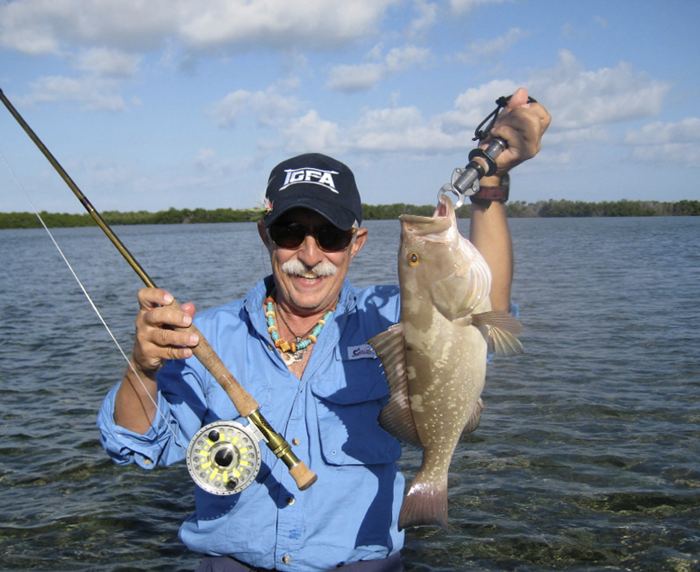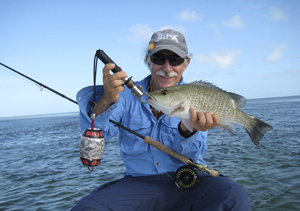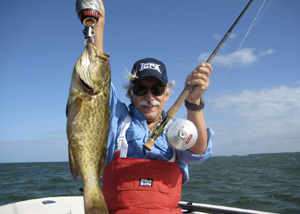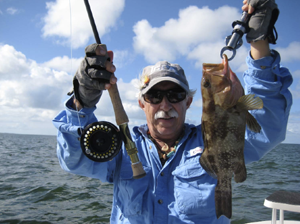
Above, world record red grouper 3-pounds on 6-pound tippet (12/20/2007) – Arostequi photos throughout story
By Steve Kantner
[dropcap]I[/dropcap]’d caught snappers on flies before. The same goes for groupers and other known bottom feeders. Yet while the proverbial blind squirrel can find the occasional nut, he’s not likely to do it on a regular basis. Most of the time, I was blind-casting, although I vaguely remember once working the mangroves. What, exactly, was I doing at the time? Why, fly fishing for mangrove snappers.
I’d catch a few bottom dwellers on floating lines and, occasionally, on intermediates. I had nothing against the faster-sinking models. However, I’d never taken time to “drop the bomb” until several offshore trips really opened my eyes. It eventually caused me to change my thinking – after experiencing the thrills and aching shoulders that were part of this shadowy world. I had to admit that a whole new dimension lay hidden beneath the waves. And there was only one way to get there.
Most fishermen will agree that, up until recently, snappers and groupers weren’t mainstream fare. Not for anglers who are addicted to flies. Has it something to do with the unseen deliveries that inevitably take place in the ocean’s depths? Or the nagging suspicion that so-called “dredging” violates our sport’s intrinsics?
Doesn’t history remind us that the London Flyfishers tried to blackball G.E.M. Skues for corrupting the River Test by bribing its trout with soggy wet flies? Meanwhile, who could resist such forbidden fruit?
Fishing deep is deliciously heretical. Partly, I suppose, because it’s highly-effective, while it flies in the face of established tradition. Perhaps another reason why purists abhor it is the simplicity of fishing beneath the billows. Or maybe they don’t know how? In the halcyon days of woven silk lines, we had dress them to make them float. Isn’t that just like today’s slow-sinkers? (Silk lines are still available from a source in England). Eventually an expert took the plunge (so-to-speak).
That expert was Miamian, Chico Fernandez. Despite his love affair with fishing the flats, he and friend, Norman Duncan decided to catch a “true” red snapper – in Chico’s case, on fly. That was back in the 1970’s, when the two made plans to rendezvous with a Cape Canaveral commercial fisherman in hopes of outwitting the fish of their dreams.
The arrangement paid-off. The commercial fisherman guided them to an offshore location where according to Chico, they landed several big reds right off the bat. But those fish were caught on plug tackle. However, Chico remembers drifting in 80 feet of water, and how the snappers began stacking-up under Duncan’s skiff. That’s when he switched to fly gear – including a reel spooled with an old-style Scientific Anglers Hi-Speed Hi-D line – along with a hefty streamer.
The line made it down, and so did the fly. Not long afterwards, a fish attacked and the battle was joined in earnest. The pay-off came some time later when Chico lifted history’s first ever fly-caught red snapper. However, the catch, which weighed just over12 pounds, never made it into the record books.

World record grey snapper 2-pound, 4-ounces on 12-pound tippet 11/14/08.Back then, no one kept snapper records – not for fish caught on flies. Although Chico’s catch was considered a milestone, pundits dismissed it as being unconventional. Meanwhile, a growing chorus of modern fly fishers began insisting that conventions be damned.
I agree whole-heartedly with the enlightened attitude. There’s more than one dimension to all types of fishing, and I’m living proof that when first-timers score – say, with snappers and groupers in fairly-deep water – we end-up spreading the resource. Both snappers and groupers are a handful, one that’s approachable primarily through modern technology – one of sinking lines.
Since both families tend to hug the bottom, your fly has to make it down. So when I originally wrote this article, I spoke with Bruce Richards, then-Product Development Engineer at Scientific Anglers, who offered some historical perspective. In Richards’ words: “We’ve made sinking lines since 1961. We impregnated the originals with powdered lead. At the time, we produced several versions – each with different sink-rates. However, the renaissance took place in the early 1980’s when we switched to using tungsten.” I asked him to elaborate. “It started-out with tournament casters. As I recall, (many-times world fly casting champion) Steve Rajeff asked us to build an extremely-thin, high-density line for use in competition. We did, and since then, we’ve dominated the distance events.” How far has that plummet progressed? “Tungsten gets down fast. We currently manufacture sinking lines in five different densities, not counting our intermediate model, which is actually a slow-sinker. Our fastest-sinking model to date has a sink-rate of 10 inches per second.” Now, go hang that on the bottom: But when Bruce continued, he raised a point: “We’ve had anglers hook tarpon 100 feet down. But when they hook a fish that far down, they have a lot of trouble moving it.” I understood, while recognizing a familiar lament. In Bruce’s words. “I was fishing out of Key West with Captain Jose Wejebe, when a monster grouper grabbed an amberjack I was fighting. I didn’t want the grouper to get the fish, so I gave it all I had.”
Something rang a bell
“I ended-up fighting the grouper for 15 minutes before it finally let go. When I landed the jack, which must have weighed 30 pounds, it was pretty beaten-up. I tried to release it, but you can guess what happened.”
It’s a fact that groupers have attitudes, which I learned first-hand under similar circumstances. I was explaining to Key West guide, Capt. Ralph Delph that an amberjack I’d hooked must have made it back to the wreck. That’s when Delph said that there was no wreck.
I was rigged with a heavy tippet, but this Goliath didn’t care. Delph had watched the attack on his depth recorder. By the time I broke this monster off, it was halfway to Istanbul.
Incidentally, Ralph Delph and certain other Key West captains are among the world’s leading experts, when it comes to catching snapper and grouper on light tackle. Over several decades, Delph has led his customers to an astonishing number of IGFA World Records. Eclipsing his encyclopedic knowledge of light-tackle techniques is a secret log that contains practically every worthwhile Loran and GPS coordinate within striking distance of Key West.
Striking distance is a relative term. One day when Marty Arostegui (who knows a few things about light tackle) and I were fishing with Delph, Ralph made a last-minute decision to go after the IGFA’s newly-opened red and gag grouper categories.
Good call. Marty was rigged with 20-pound class tippet while I, who had never done this type of fishing before, opted for 16-pound class. We endured an hour-and-a half run at full-throttle speed before ever wetting a line. However, when we did, it was worth every bounce.
We jumped between locations, while following the tide, and quit each time when the action slowed. In the end, we landed two species of snapper and three of grouper. Three of these fish later qualified as World Records.
Personally, I’m not an “awards” kind of guy. However, anyone familiar with the process should recognize that the International Game Fish Association is paying closer attention to both snappers and groupers. Several categories have opened-up – in both the fly and general divisions, including red and gag grouper, as well as mangrove and yellowtail snapper.
Take heart, you prospective dredgers. I say that because more of you are turning to Florida’s reefs. We’re literally surrounded by snappers and groupers, but you have to head offshore to find the best fishing. The most-effective strategy consists of anchoring over productive bottom before casting up-current and allowing your line and fly to sink.
Part of the drill involves getting down without hanging-up, which means carefully controlling your running line. Reef fish respond to chum, which brings them closer to the surface. However, an astute fly fisherman takes the mountain to Mohammet if the fish refuse to oblige. It goes without saying that a depth recorder is essential, as is the proper fly line.
As for my choice of fly lines: I’d say a number 11 or 12 super-fast sinking head (say, 550 grains), matched with an intermediate running line. It gets the fly down, without snagging the running line. For the ultimate set-up, whip a loop at one end of a 100-foot spool of running line before repeating the process with several different 30-foot sinking shooting heads. This creates an interchangeable system that’s capable of handling most situations. That’s the way Marty Arostegui does it, and he has more records than anyone.
Where to pursue snappers with a fly rod? You’ll find mangroves in the shallows, especially around patch reefs, wrecks, and other obstructions. But they stray into deep water, as well. Conversely, yellowtails prefer depths ranging from 30 to 50 feet, although it’s not unusual to find them in as little as 20.
‘Tails are a mid-water species that school in the vicinity of coral heads. They require good water quality and are more-common during the summer months. If you’re interested in tangling with muttons or true reds, look for them over the outer reefs in depths ranging from 50 to 100 feet, especially in areas that are heavily-fished.
[information]
NOTE: All of the photos in this article where taken by Marty Arostequi and are world record catches caught by Marty Arostequi in Marathon, Florida. In all instances, Marty used Tibor Reels with Scientific Anglers-Slow Sinking Clear fly line. The fly used in all instances were pilchard imitation Clouser’s tied with white and grey buck tail. Also, the guide in all instances was Capt. Chris Morrison, Marathon, FL.
Fly Life staff member Marty Arostequi has the most IGFA world records ever held by one person (over 400).
[/information]
Few experts argue that the best grouper fishing takes place between 30 and 60 feet. That takes into account the limitations of fly tackle, while disregarding a few geographical exceptions. Take for example, certain shallow Gulf wrecks where gags tend to congregate during winter cold snaps.
The massive Goliath is an inshore species that, after being harvested to the brink of extinction, seems to be making a comeback. Even these big boys take a fly, as evinced by Bart Foth’s massive 356 pounder taken in Florida Bay back in 1967. Since parts of this article were originally published, I hooked three Goliaths one day that weighed anywhere from 60 to around 120 pounds.
I could have dragged the biggest one into the boat, which would have been my first on fly. We were fishing in 17 feet of water, and all three were following others that we’d hooked accidentally. Meanwhile, Goliath fishing is catch-and-release, and that’s all I’m going to say about it.
Of course, fly-caught groupers are nothing new. Capt. John Donnell and I hooked our share in North Lake Worth more than 20 years ago. We’d be drifting the flats near Munion Island when a “football” would grab our streamers. In those days, we relied on floating lines. Although we were unable to make a positive ID, we decided to release these fish unharmed. Call it Political Correctness ahead of its time.
I recall certain other catches, like a mangrove snapper at Coral Cove Park, just north of Jupiter Inlet. I was casting a fly in the surf for snook.
As far as fly patterns for snapper and grouper, the most-successful imitate baitfish. That’s especially true offshore. Of course, it helps to choose ones that are weighted. Of the various pattern I’m familiar with, none is more effective – or easier to tie – than an ordinary white Clouser Minnow.
Whenever I fish with Lefty Kreh, he wants to add to his “Clouser List.” At the time I originally wrote this article, he’d totally nearly 90 species on this popular pattern – one which he helped Bob Clouser develop. Clousers are ideal for snappers and groupers. As a footnote to fishing for snappers, Lefty refers to the Nieu Guinea Bass (a Pacific estuarine snapper) as “the toughest fish that swims.”
While a fly’s ability to sink is important, just how far depends on several factors, including current, water depth, and how deep the fish are holding. Tide enters into the equation, and it’s directly related to the phase of the moon (a full or new moon create stronger “spring” tides).
So learn to rely on your depth recorder, as well as on any applicable tide tables. And don’t forget that too much current can make bottom-fishing with flies impossible. Suggested solutions include fishing slack tide, or shallower water, if it’s a viable.
While reef species tend to increase in abundance the further you head offshore, there’s a hypothetical point beyond which fly fishing becomes impractical, due to the depth of the water. But a run to deep water isn’t always necessary.
Take the Bahamas, where limited pollution, plenty of fish, and an overall lack of fishing pressure are responsible for an enviable shallow water habitat. Before attempting to fish in Bahamian waters, be sure to check-in with Customs. And purchase a Bahamian Fishing Permit. I saw another example of a pristine environment in the waters around Key West.
Ralph Delph chums yellowtails to within inches of the surface. A patch reef was visible when I watched him do it, but you’d need a Coast Guard search plane in order to find it. Or us for that matter. I was rigged with an epoxy Surf Dart, but those ‘tails would have gobbled a French fry. Like I believed in the beginning, you needn’t always go deep.
On a similar note, Marty Arostegui recently started fishing with Capt. Chris Morrison of Marathon, Florida. Morrison – who’s an expert at locating shallow water snapper and grouper – has already led Arostegui to a number of fly rod World Records. The photos accompanying this article are of fish that were caught while the two fished together.
So are deep lines the wave of the future? It’s a possibility – with limited water to go around – and fly fishermen are bound to address it. In the meantime, Bruce Richards referred to these marvels as “fly fishing’s biggest frontier.” Ask anyone who’s ever tried one, and I think they’ll probably agree.










Hi,
great artical. Can you tell me what the technique you used to fly fish. how you made your line to sink deep to 100 feet
Thanks